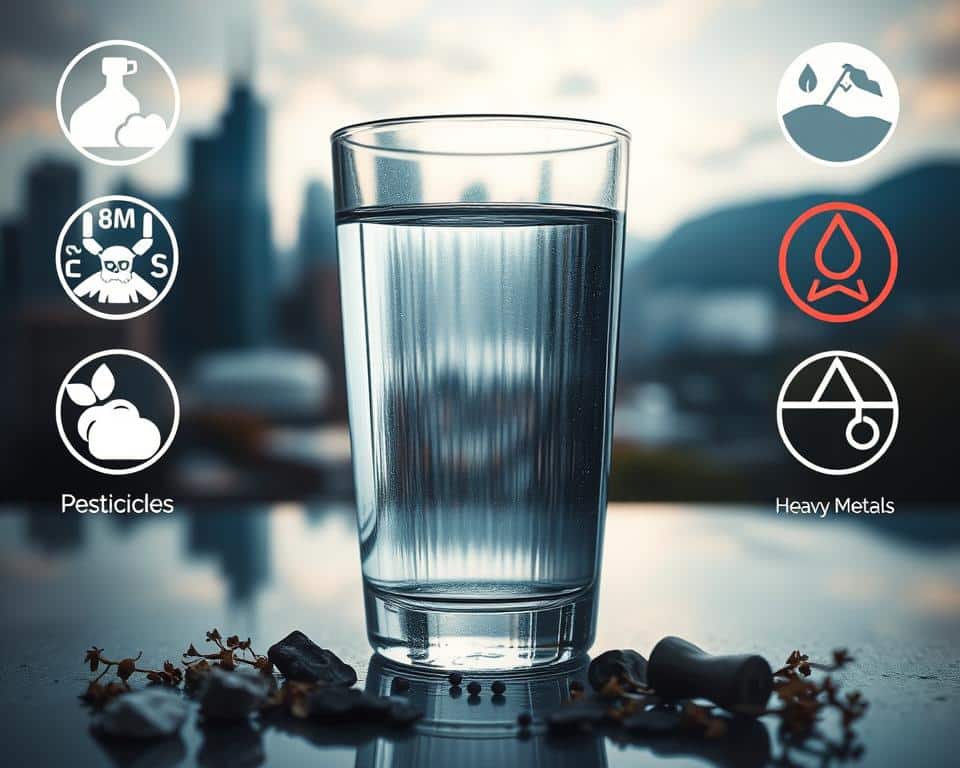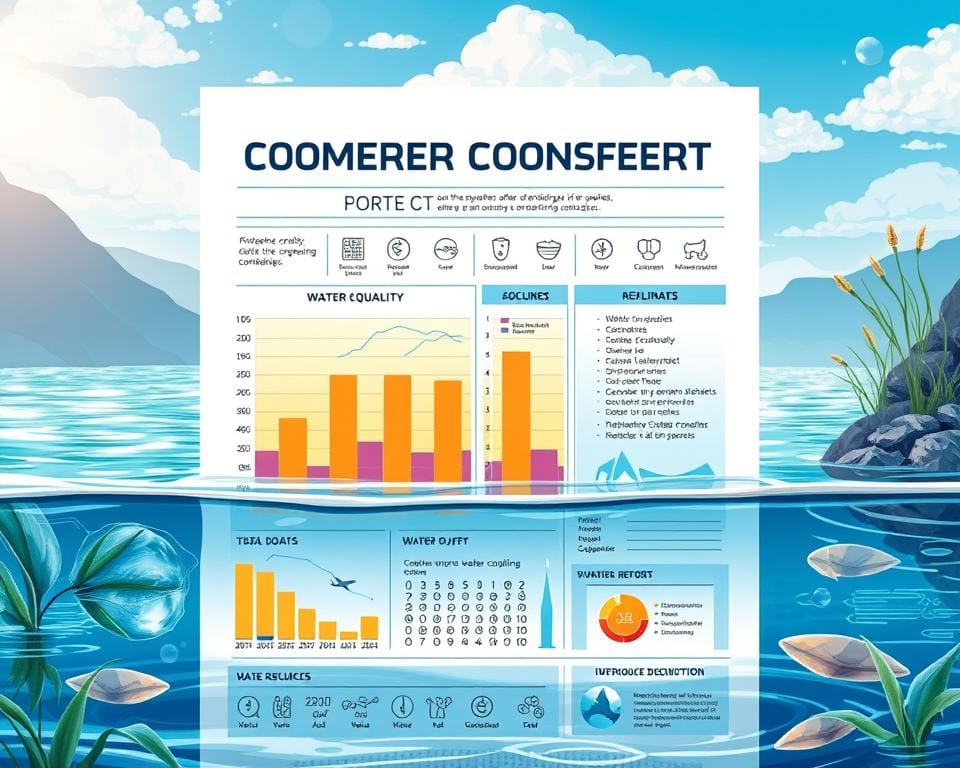If you use a public water system, you’ll get a Consumer Confidence Report (CCR) every year by July 1st. The EPA requires this report under the Safe Drinking Water Act (SDWA). It tells you about your water’s safety, where it comes from, what contaminants it might have, and any violations that have happened. This lets me track tap water safety and check if it follows EPA standards.
Over 170,000 public water systems provide Americans with clean drinking water. Knowing what’s in your CCR can help you make smart choices for your health. Even if your water bill is paid through a landlord, you can still find the report online or ask for it. It tells you about where your water’s from and what’s in it.
The EPA has set limits for about 90 toxic chemicals out of more than 75,000. In my CCR, I learn about potential pollutants and their effects on health. For help understanding these reports, visiting the CDC’s website is very useful.
Understanding the Consumer Confidence Report (CCR)
The Consumer Confidence Report, or CCR, is a vital document given to customers by community water systems. It started with a key 1998 change to the Safe Drinking Water Act, focusing on public health and safety. This change requires water systems to share their water quality data with residents every year.
The importance of the CCR is huge. It encourages transparency and holds governments responsible for water quality. Starting in 2027, water systems with over 10,000 customers must send these reports twice a year. This is a big step towards better transparency and protecting public health.
History and Legislation
The need for a CCR came from changes to the Safe Drinking Water Act in 1996. The EPA oversees drinking water quality by setting national rules. It also supports water systems with technical and financial help. These efforts prevent waterborne diseases and contamination.
With the updated rule, systems serving more than 100,000 people must plan for translation help by 2027. Systems serving 50,000 must put the CCR online. Also, states must send water system compliance data to the EPA each year.
What Information is Included?
The CCR shares key info about our drinking water. It lists any found contaminants, their health impacts, where the water comes from, and any rule violations. The report makes it easier for people to understand their water quality and potential risks.
- Details on the source of the water
- Information on detected contaminants
- Possible health effects of these contaminants
- Any violations of drinking water regulations
To learn more, you can call the EPA’s Safe Drinking Water Hotline at 1-800-426-4791, or check government and local water utility sites.
People using water from community systems get this report each year. But, those with private wells don’t get CCRs since the EPA doesn’t regulate them. Yet, they can check their water safety with SimpleLab’s Tap Score kits. These kits test for over 400 contaminants and give unbiased health advice and treatment options.
For more on buying distilled water and other details, check the guide here.
Where Your Tap Water Comes From
Knowing where tap water comes from is key to ensuring it’s safe and clean. The Consumer Confidence Report (CCR) tells us about the water’s source like rivers, groundwater, and reservoirs. It’s important to know this so we understand the treatment it goes through to be safe to drink.
Source Water Defined
Source water is the water from rivers, lakes, groundwater, and reservoirs that becomes our drinking water. In the U.S., most people get their water from public systems. These are checked by the EPA to make sure they’re safe from over 90 harmful things. However, people with private wells need to check their water on their own.

Local Water Sources Explained
Different places in the country get their water from different natural sources. For example, Cleveland’s water comes from the Sparta Aquifer. In 2023, Cleveland and other areas checked their water carefully for any bad stuff. They made sure everything was safe and met the rules.
The CCR shows what’s in the water, where it comes from, and how it’s cleaned. It helps us know the risks and how to protect our water. In Ogdensburg, New York, the water system supports over 10,000 people. It produces a lot of water every year, showing why we must keep our water sources safe.
To keep our local water quality high, it’s important to keep an eye on it and get involved. You can learn more by looking at your water system’s reports. For more info, check out What’s In My Water.
| Location | Source | Volume (Gallons) | Contaminants Detected | Action Taken |
|---|---|---|---|---|
| Ogdensburg, NY | Local Rivers and Reservoirs | 622,039,000 | Lead, Fluoride, Nitrate | Regular Monitoring |
| Cleveland, OH | Sparta Aquifer | – | Total Coliform Bacteria, Sodium | Treated and Compliant |
Identifying Contaminants in Your Water
Understanding what’s in your tap water is key for its purity and safety. Water contaminants range from germs to chemicals, some added, like chlorine, to kill germs. They’re okay in small amounts.
It’s important to know the contaminants and their safe levels. This knowledge lets you choose the right treatment and ensures water safety.
The Drinking Water Quality Council evaluates water standards. It’s a team of experts from different fields, ensuring meetings are open for public input. They adhere to New York’s Open Meetings Law.
Since 1996, New York law requires big water systems to share Annual Water Quality Reports. These reports talk about contaminants and how they follow the Safe Drinking Water Act. Updated in 2001, they now include more data for transparency.
In the US, 90% get water from public systems. The Tracking Network keeps an eye on water quality, sharing information on its safety and potential risks. This data helps manage water purity and the health of the community.
| Contaminant | Potential Health Hazard | Water Safety Standard |
|---|---|---|
| Lead | Developmental delays in children | 0 ppb (EPA action level 15 ppb) |
| Chlorine | Eye/nose irritation, stomach discomfort | 4 ppm |
| Arsenic | Increased cancer risk | 10 ppb |
| Nitrate | Blue baby syndrome | 10 ppm |
Health Risks Explained
Understanding both biological and chemical contaminants in drinking water is crucial. Public water systems test and report on potential threats for safety. The EPA requires these systems to give a yearly water quality report, called the Consumer Confidence Report (CCR).
Common Germs and Chemicals
Germs like Cryptosporidium, Giardia, and E. coli can make people sick. They come from human and animal waste in water. Chemicals such as lead, nitrate, and arsenic are also dangerous. They are really harmful to babies and young kids, showing why strict water quality is vital.

Health Impact of Contaminants
Water contaminants can cause many health problems. Harmful germs lead to stomach issues like diarrhea and nausea. Chemicals like lead harm children and pregnant people, causing learning delays. Even with better water treatment now, protecting water sources and testing, including private wells, is key.
To lower these health risks, states must report their water testing every year. This shows the continuous effort to keep public health safe. If concerned about water safety, getting it tested at state-certified labs or health departments is a good step. Knowing about these risks helps us keep our communities safe and healthy.
Reading the Water Quality Report Table
Understanding the water quality report table may seem hard at first. But, learning the important terms and how to read the numbers can be very helpful. This knowledge helps people know if their tap water is safe and clean.
Key Terms and Definitions
Knowing the basic terms is key when looking at the water quality report. Here are some important definitions you’ll see:
- Maximum Contaminant Level Goal (MCLG): Indicates the level of a contaminant in drinking water below which there is no known or expected risk to health. MCLGs are set with a safety margin in mind.
- Maximum Residual Disinfectant Level Goal (MRDLG): This goal shows the level of water disinfectant below which there is no known or expected health risk.
- Maximum Contaminant Level (MCL): An MCL is an enforceable limit. It is the highest level of a contaminant allowed in drinking water, according to EPA health standards.
- Action Level (AL): Action Levels are thresholds that, when exceeded, require a water system to take certain actions. They are not the same as MCLs.
- Treatment Technique (TT): This is a required method intended to reduce the level of a contaminant in drinking water. TTs are essential for meeting EPA health standards.
Interpreting the Numbers
To understand CCR tables, you need to read the numbers correctly. This helps to check if water quality meets the standards. Here’s a guide on how to interpret the data:
| Substance | Typical Reported Value | EPA MCL | Detected Range | Possible Source |
|---|---|---|---|---|
| Lead | <0.015 ppm | 0.015 ppm | 0 – 0.010 ppm | Corrosion of household plumbing systems |
| Copper | <1.3 ppm | 1.3 ppm | 0 – 0.200 ppm | Corrosion of household plumbing systems |
| Fluoride | 0.7 ppm | 4.0 ppm | 0.5 – 0.8 ppm | Erosion of natural deposits |
| Chlorine | 1.0 ppm | 4.0 ppm | 0.8 – 1.2 ppm | Water additive used to control microbes |
These detailed numbers help check if water meets EPA health guidelines and spot any health risks from contaminants. Keeping an eye on these numbers ensures the safety and quality of our water. This is very important for everyone’s health.
How to Handle Violations in the Report
It’s key to first look closely at the Consumer Confidence Report (CCR) when tackling water quality concerns. This document lays out important info on any drinking water standard breaches. It tells you what went wrong, how long it happened, and the health risks involved.
In Santa Ana, actions were taken to stop using Well 38 because it had high levels of PFOA and PFOS. These levels passed the safety limits. This move shows the city’s effort to follow water safety rules and protect drinking water.
If violations show up in the CCR, the report explains how the water utility fixed the problem. This info is crucial for people to know, especially if the issues keep happening. Take Santa Ana as an example: they check for PFAS every three months and look for new ways to keep water safe.
- Review the Consumer Confidence Report for any violations.
- Understand the health risks and duration related to the violations.
- Monitor for recurring problems and consider personal water testing or home treatment systems if needed.
- Use local resources, such as the health department, for guidance on ensuring safe drinking water.
- Stay informed about community water quality projects and investments, such as infrastructure upgrades. For example, Los Angeles invested $123.8 million in a UV disinfection plant for its reservoir to improve water quality.
Moreover, being active in following water standard updates and supporting local water quality efforts makes a big impact. It’s all about making sure our drinking water is safe and meets strict health standards.
Public Involvement in Water Quality Decisions
Public involvement is key to managing and improving our water systems. The review by the California Department of Water Resources shows how community input helps better water quality. When plans don’t meet standards, the State Water Board takes over. They protect our groundwater until local teams can manage it sustainably. Citizens play a big role in this, affecting the water quality directly.
Public workshops and hearings are great for getting people involved. During these times, the State Water Board listens to everyone. This method boosts water management and helps everyone feel responsible. This leads to better water quality over time.
Citizen science has become important for tracking water quality. Programs like Arkansas’ StreamSmart and Lake Geneva’s project show how volunteers can make a difference. From Turkey to the United States, people use simple tools to help. Their efforts, along with advanced monitoring, provide vital data for water management.
It’s important to know how to get involved during state interventions. The State Water Board offers many ways to participate. This includes meter installations and reporting for groundwater pumpers. If things don’t get better, the Board might put together a temporary plan. This also needs public input and agreement.
When local groups show they can manage water sustainably, the State Board steps back. Public involvement is crucial for reaching these goals. Through active participation, communities and the CCR work together. They keep improving water quality together.
Conclusion
Learning to read public water quality reports helps keep us informed about our drinking water’s safety. The National Water Quality Portal provides data from the U.S. Geological Survey and Environmental Protection Agency. This shows the importance of easy access to detailed water quality information.
The Consumer Confidence Report (CCR) offers details on the source, quality, and safety of our water. In 2023, Corning provided 11,100 people with 313 million gallons of water. Meanwhile, Portland’s Bull Run Watershed shares info on water hardness and pH levels.
It’s crucial for us to check these reports every year and understand the data they contain. We should also get involved with local water systems. Using tools like How’s My Waterway? and the Rain Garden App can help. This way, we play a key part in keeping our community healthy and safe.

